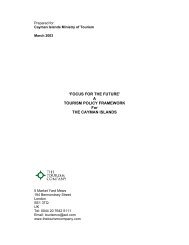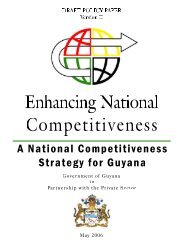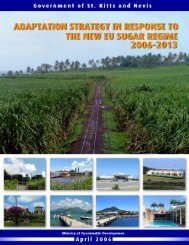Business Removing
Doing Business in 2005 -- Removing Obstacles to Growth
Doing Business in 2005 -- Removing Obstacles to Growth
- No tags were found...
You also want an ePaper? Increase the reach of your titles
YUMPU automatically turns print PDFs into web optimized ePapers that Google loves.
MEASURING WITH IMPACT 15<br />
What is new?<br />
Three new sets of indicators have been developed, showing<br />
the regulations an entrepreneur faces when registering<br />
property, protecting investors and dealing with business<br />
licenses. The data for the first 2 sets are presented in<br />
this report. Information on business licenses has been so<br />
difficult to collect in some countries that the data will<br />
become available on the Doing <strong>Business</strong> website in November.<br />
The following indicators are constructed:<br />
• Registering property—procedures, time and cost to<br />
register property. The indicators are constructed<br />
assuming a standardized case of a business that wants to<br />
purchase land and buildings in the peri-urban area of<br />
the most populous city. The property is already recorded<br />
in the registry and cadastre, free of title dispute and valued<br />
at 50 times income per capita. The indicators measure<br />
the time and cost to comply with all necessary procedures<br />
to register the transfer of title from the seller to<br />
the buyer.<br />
• Protecting investors—an index of ownership and financial<br />
disclosure. Seven types of disclosure make up the<br />
indicator—by reporting family, indirect and beneficial<br />
ownership, and on voting agreements between shareholders,<br />
by requiring audit committees and the use of<br />
external auditors and by making such information available<br />
to all current and potential investors. The data come<br />
from a survey of corporate and securities lawyers. They<br />
measure the highest available disclosure, reflecting the<br />
choices of small investors to put their money in publicly<br />
listed or privately held companies. In countries where<br />
stock exchange regulations and securities laws are in<br />
force, the disclosure index assesses these regulations. In<br />
other countries, the disclosure requirements come from<br />
the company law. So the indicators are relevant for private<br />
companies as well as publicly listed ones.<br />
• Dealing with business licenses—procedures, time<br />
and cost to obtain business licenses and permits for ongoing<br />
operations. Because licenses are industry-specific,<br />
the data are built for a case in the construction industry.<br />
In future years the data will cover other major industries.<br />
The same standardized case used in building the starting<br />
a business data is applied to assess the procedures, time<br />
and cost necessary for the business to operate legally in<br />
the construction industry, after completing all required<br />
general registration procedures. Next, a new standardized<br />
case is developed to measure the formalities necessary<br />
for ongoing operations in the construction industry—assuming<br />
that the operations are to build a<br />
warehouse in the peri-urban area of the most populous<br />
city. Technical characteristics of the warehouse are described<br />
to construction and real estate lawyers and construction<br />
associations who answered the survey. Indicators<br />
measure the procedures, time and cost to comply<br />
with all necessary regulations and formalities to complete<br />
the warehouse construction—from obtaining a location<br />
permit or building permit to obtaining utility<br />
connections and registering the new building.<br />
Detailed explanations on the construction of indicators,<br />
including the new ones, are available in the Data<br />
Notes section.<br />
Notes<br />
1. Several papers are already published, including Djankov and others<br />
(2002), Djankov and others (2003a), Djankov and others (2003b), and<br />
Botero and others (forthcoming). Two other papers—Djankov,<br />
McLiesh and Shleifer (2004) and Djankov and others (forthcoming)—<br />
are the basis for the Getting Credit and Closing a <strong>Business</strong> chapters, respectively.<br />
2. These include, among others, Rajan and Zingales (2003), Klapper,<br />
Laeven and Rajan (2004), Bolaky and Freund (2004), Lerner and<br />
Schoar (2004), Acemoglu (2003), Mulligan and Shleifer (2003), Hoekman,<br />
Kee and Olarreaga (2003) and Smarzynska and Spatareanu<br />
(2004).<br />
3. In the surveys, respondents are asked whether they wish to have their<br />
names and contacts printed. A small percentage have requested<br />
anonymity.<br />
4. Booz, Allen and Hamilton (2004).<br />
5. Questions about the methodology can be asked at http://rru.worldbank.<br />
org/doingbusiness/askquestion and will be answered within 48<br />
hours. Readers who wish to contest the data are referred to the detailed<br />
methodology in the Data Notes or at<br />
http://rru.worldbank.org/doingbusiness/ methodology and to the procedure<br />
by procedure data on the Doing <strong>Business</strong> website. For example,<br />
in contesting the Starting a <strong>Business</strong> data on Albania, the reader<br />
should look at http://rru.doingbusiness.org/<br />
doingbusiness/exploretopics/startingbusiness/economies/albania.pdf.<br />
6. SEBRAE (2000), World Bank Investment Climate Assessments, available<br />
at http://www.worldbank.org/privatesector/ic/ic_country_report.htm.

















